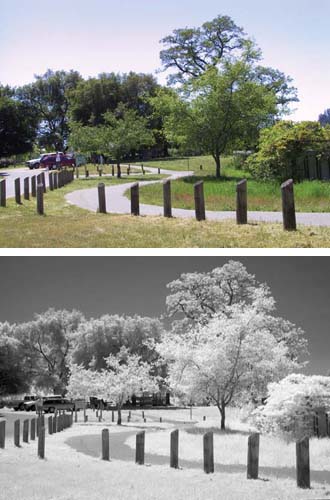3.18. Digital Movies Movie making probably wasn't what you had in mind when you bought a digital still camera. Even so, most cameras offer this feature, and it can come in handy now and then. Movie mode lets you capture QuickTime video, often with sound, and save it to your memory card right alongside your still pictures. Some cameras permit only 30 seconds of video per attempt; others let you keep recording until the memory card is full. POWER USERS' CLINIC
Infrared Black-and-White Photography | | Black-and-white photography no longer dominates the print world as it did during the heyday of Life magazine, but it's still popular. Black-and-white shots impart a special artistic feeling that's often lacking in color shots. Unfortunately, many of the tricks used by expert black-and-white artists aren't readily available to casual photographers employing digital means without a visit to high-end image editors like Photoshop. There is, however, a powerful black-and-white alternative that doesn't require an advanced degree in photo editing: infrared photography. Infrared photography deals with the spectrum of light that you can't see but your digital camera can. It's an option only if your camera accepts filters ”and if you're willing to buy an infrared filter, which eliminates the visible spectrum and captures only the infrared rays. The first thing you'll notice in infrared photography is that the blue sky goes dark and that most trees turn very light. Glare is minimized, as you can see by the road in the before-and-after examples shown here. The most popular filter for digicam infrared photography is the Hoya R72. If your camera accepts filters, then go to the camera store, attach the R72, and look at a brightly lit scene on the LCD screen. You'll know right away if your camera is suitable for this kind of photography. Older digital cameras, like the Nikon CoolPix 900, often work better for infrared photography because they don't have the wave-blocking infrared filters of newer models. But even today, certain specialty cameras, like the Canon EOS 20Da, perform well for infrared and astrophotography because they don't have the infrared cutoff filter. If you're lucky enough to have a camera that can capture infrared images and accept filters, then get your hands on a Hoya R72 and go have some fun. You can create some astonishing pictures that will attract lots of attention.  |
Once you've transferred the movie to your Mac, you can play it, email it to people, or post it on a Web page. Now, for many years , iPhoto didn't do movies. If you wanted to transfer your camera's movies to the Mac, you had to resort to preposterous workarounds like switching to the Finder and manually dragging them off the memory card's icon. iPhoto 5, though, gracefully imports the movies along with the still photos. You can find details on importing and playing them on page 92; details on editing them are in Chapter 11. (You can use either iMovie or QuickTime Player Pro.) These movies usually have modest dimensions (typically 320 x 240 pixels, which would fill one quarter of a TV screen), so it's best to keep your expectations low. Even so, life is filled with situations when a few frames of QuickTime are better than no movies at all. Just keep these pointers in mind: -
Remember your memory. Digital movies, even these low-quality ones, fill up your memory card in seconds. Remember, you're shooting 15 or 30 little pictures per second. This is 512 MB or 1 GB card territory. -
Steady the camera. If you don't have a tripod, put the camera strap around your neck, pull the camera outward so the strap is taut, and only then begin filming . The strap steadies the camera. -
Don't try it in the dark. The flash doesn't work for movies, so look for the best lighting possible before composing your shot. |
